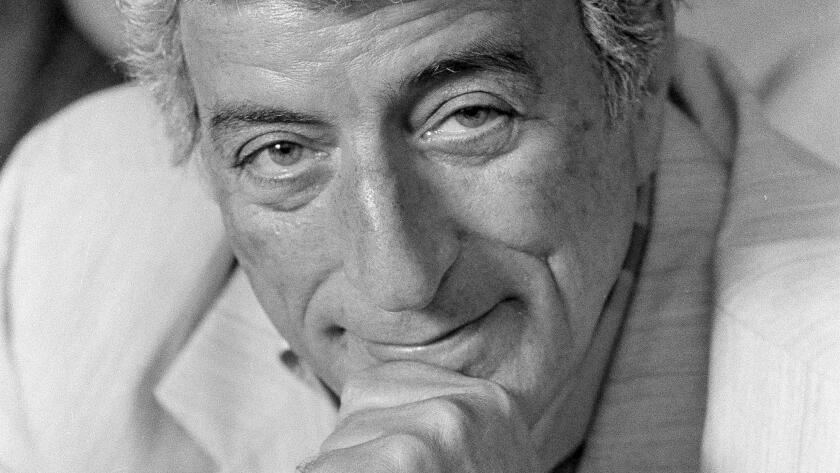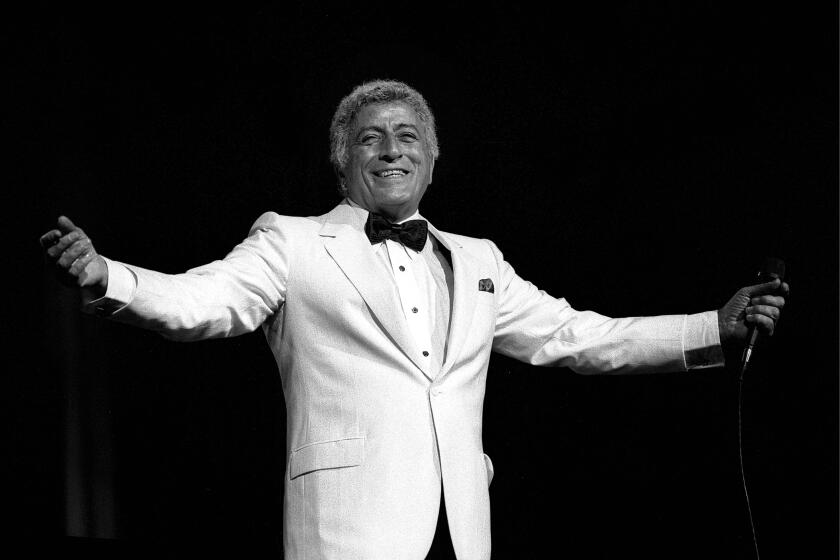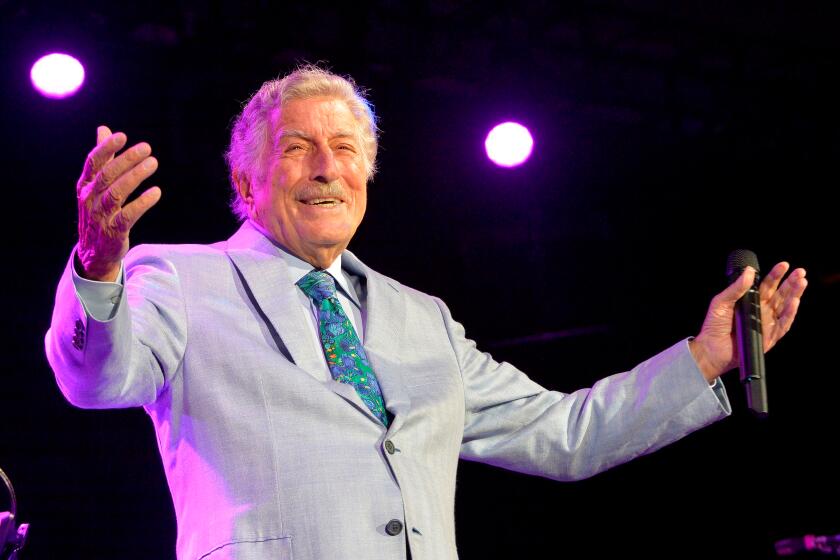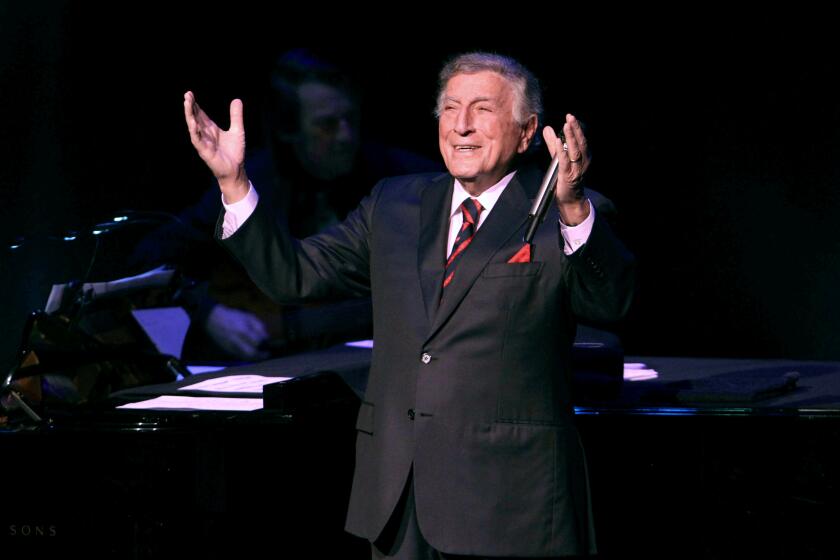Tony Bennett, timeless singer who won over fans for decades, dies at 96
- Share via
A consummate performer with a remarkable ability to revive his career again and again, Tony Bennett won admirers from Frank Sinatra to Lady Gaga.
- Share via
Tony Bennett, the enduring New York City crooner who famously left his heart in San Francisco and melted hearts all over the world during his more than seven decades on the music scene, died Friday. He was 96, just two weeks short of his birthday.
Publicist Sylvia Weiner confirmed Bennett’s death to the Associated Press, saying he died in his hometown of New York. No specific cause was cited, but Bennett had been diagnosed with Alzheimer’s disease in 2016.
Adored by fans and held in the highest regard by musicians from Frank Sinatra to Lady Gaga, Bennett was a consummate performer who had a remarkable ability to endear himself to new generations of listeners, even as his contemporaries faded away. Sinatra once called him “for my money the best singer in the business, the best exponent of a song.”
In all, Bennett made dozens of albums and sold millions of records in a career that seemed to stretch seamlessly through the decades and changing musical landscape. For much of his career he was perpetually on the road, sometimes performing 200 shows a year. And though he had occasional periods when his career ebbed as his repertoire went out of style, he repeatedly found new fans who flocked to his concerts and snapped up his records.
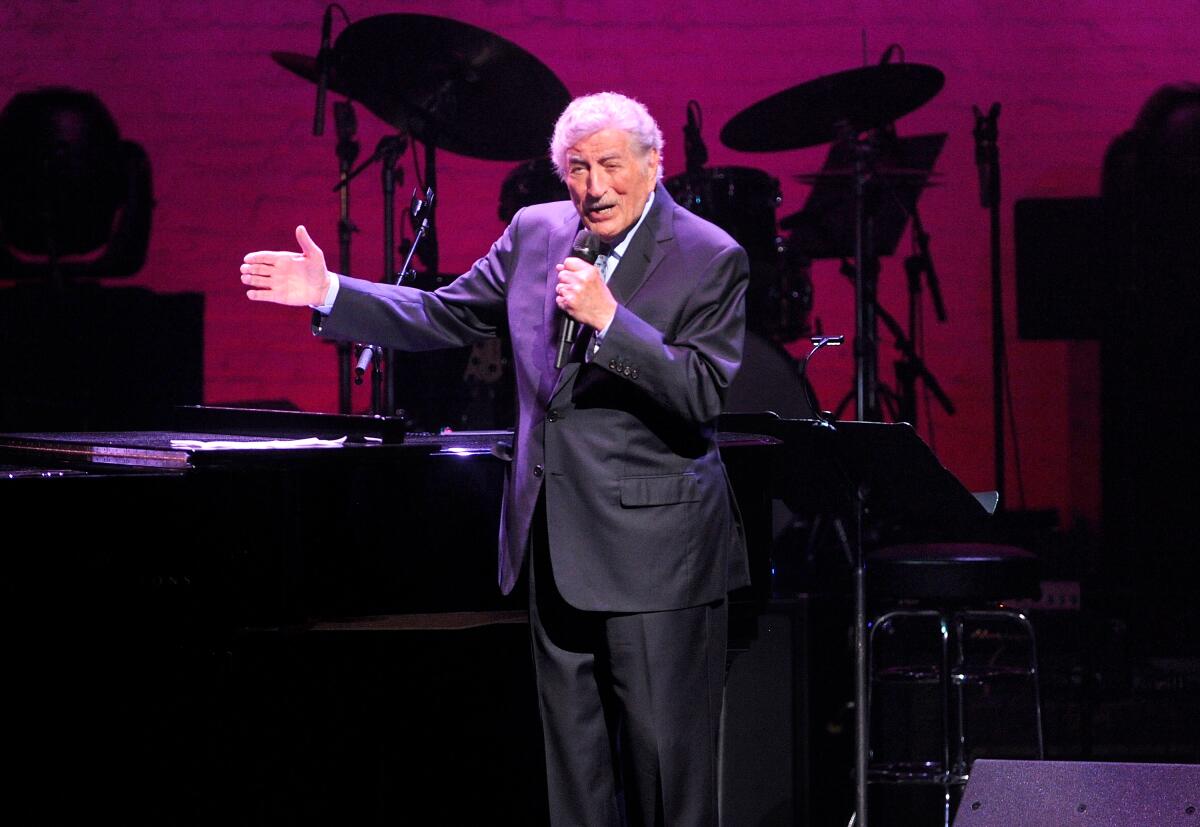
In 2014, Bennett became the oldest living artist to reach No.1 on the Billboard charts when he teamed up with Lady Gaga on the standards-only recording “Cheek to Cheek.” It broke the record he had set only three years earlier when he reached No.1 with his album “Duets II,” featuring pairings with Amy Winehouse, Mariah Carey, Carrie Underwood, Faith Hill and other far-younger singers. In 2022, he became the second-oldest Grammy winner with “Love for Sale,” a collection of Cole Porter standards recorded with Gaga.
Instantly identifiable, Bennett’s voice was a source of warmth and welcoming, of quick wit and steady wisdom. The singer died on Friday at 96.
Starting in the clubs of Manhattan in the 1940s, Bennett rose to popularity before the advent of rock ’n’ roll, and, though pressured by his record label to become a rocker, he took the advice of his friend Count Basie, who said, “Why change an apple?”
With the help of “I Left My Heart in San Francisco” — the song that won him his first Grammy and became his signature tune from the time it was released in 1962 — Bennett kept performing, doing it his way.
In the 1990s, in a miracle of savvy marketing masterminded by his son and manager, Danny, Bennett became the elder darling of the MTV set. He appeared as an animated special guest on “The Simpsons,” and — though he never actually had been “plugged” in the first place — he made a much-heralded appearance on “MTV Unplugged.” The resulting album earned him a Grammy for album of the year in 1994.
Two decades later, his career reached full boil again when he hit the road with Lady Gaga and sailed off with a Grammy for “Cheek to Cheek.” He won his 19th the following year with “The Silver Lining: The Songs of Jerome Kern.”
“There’s nothing hipper than being talented at something you love, in having passion, and that is classic, and that is timeless,” Gaga said in 2015.

Lady Gaga announces “Love for Sale,” her second album with Tony Bennett. She and the birthday boy, who has Alzheimer’s, perform tonight and Thursday.
Bennett touched on winning over younger audiences in “The Good Life,” the 1998 autobiography he wrote with Will Friedwald. “You can’t imagine how rewarding this is, and how much it affirms what I fought so long and hard for.”
Bennett enjoyed immense popularity through his 70s, 80s and into his 90s. And he had the deep respect of his peers, from Bob Hope, who helped discover him and gave him his stage name of Tony Bennett, to Basie, Judy Garland, Pearl Bailey — and, especially his idol, Sinatra.
“He excites me when I watch him — he moves me,” Sinatra said in a 1965 Life magazine article. “He’s the singer who gets across what the composer has in mind, and probably a little more. There’s a feeling in back of it.”
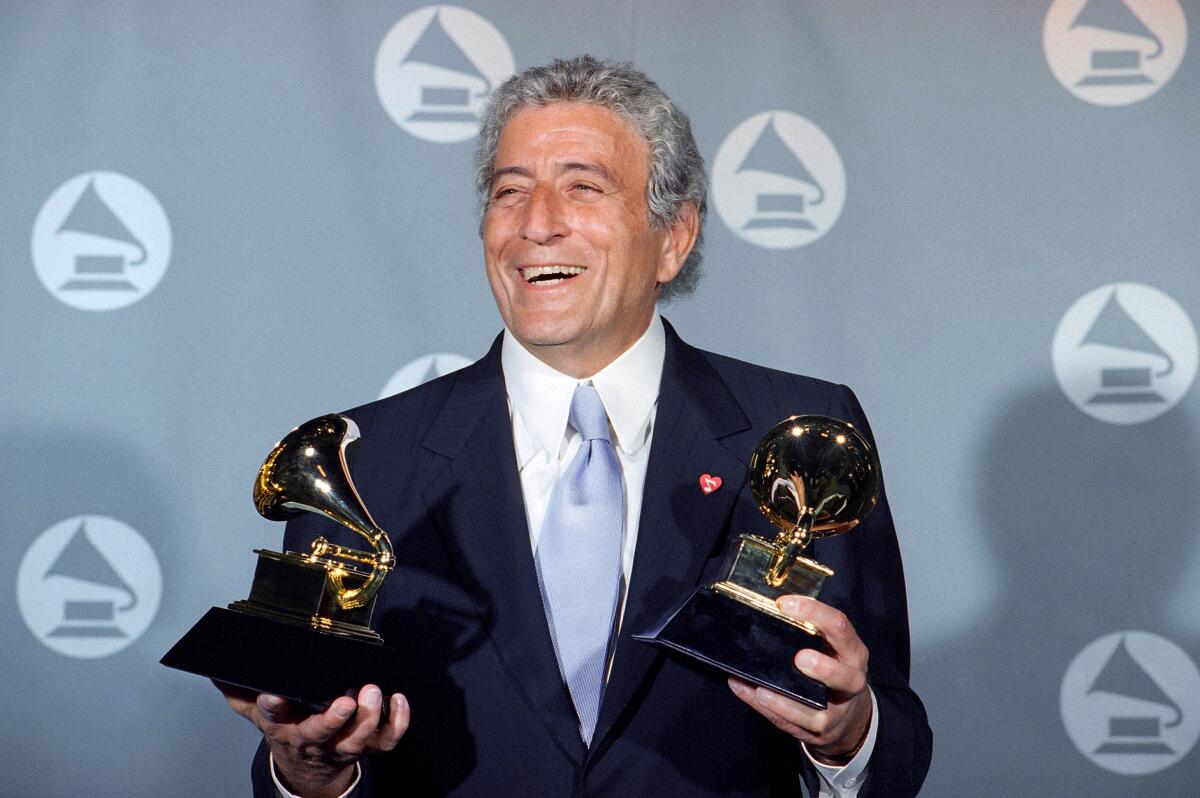
“That quote changed my whole life,” Bennett wrote in “The Good Life.” “It was probably the most generous act that one artist has ever done for another.”
In 1992, Bennett paid a special tribute to his idol with his 55th album for Columbia Records, “Perfectly Frank,” which included such Sinatra hits as “One for My Baby” and “Night and Day.” Except for a 14-year period from the mid-1970s to the mid-1980s, when Bennett recorded for other labels, the singer spent his entire career at Columbia. On his own label, Improv, he recorded with jazz pianist Bill Evans.
Tony Bennett, a timeless singer who won over fans for decades, died at 96. From Frank Sinatra to Lady Gaga, he was adored by fans and held in the highest regard by musicians. Here’s a look at him through the years.
Anthony Dominick Benedetto was born Aug. 3, 1926, in Long Island City, N.Y., the third child of Giovanni Benedetto, a grocer, and his wife, Anna. He grew up in the working-class Astoria neighborhood of Queens, which Bennett once described as “a lot like a small Midwestern town.”
When he was 10, his father died and his mother struggled to maintain the family as a seamstress.
Always interested in singing, Bennett made his first public performance at 9 at a local political gathering, and by the time he was a teenager, he was performing in clubs as Joe Bari, a name he chose because he thought it sounded less ethnic. He attended the School of Industrial Arts in Manhattan, although he didn’t graduate. By 16, he was trying to make a living working as an elevator operator and a copy boy for the Associated Press, before breaking into show business as a singing waiter in Astoria.
World War II was still going when Bennett turned 18, and he was drafted into the Army and saw combat in Germany. After the war ended in Europe, Bennett stayed in the service as part of the occupying force and started singing with various Army bands.
When he returned to the U.S., he used the G.I. Bill to study acting at New York City’s American Theatre Wing, applying what he learned to his singing. It was there he received the guidance that would serve him through his professional life: A teacher advised him not to try to imitate Sinatra or any of his favorite singers but instead try to sound like his favorite musicians. Bennett chose pianist Art Tatum for his virtuosity and tenor saxophonist Stan Getz for his honeyed sound.
“I put those two together, and I got something that came out different,” Bennett told the Chicago Tribune in 1997.
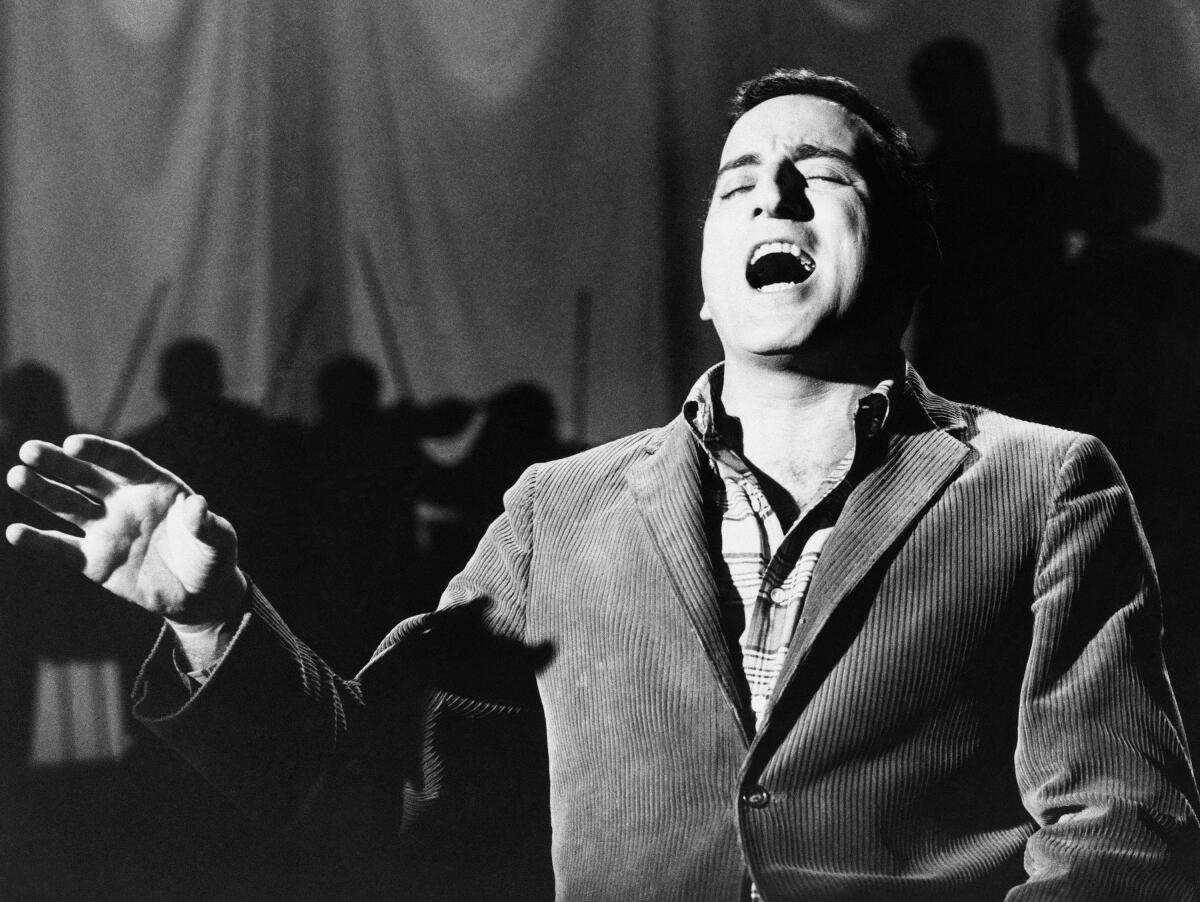

Sticking with the name Joe Bari, Bennett started haunting the nightclubs, looking for work as a singer. After years of rattling around, Bennett acquired a manager, Ray Muscarella, who got him bookings and helped polish his presentation.
The singer made a few appearances on “Arthur Godfrey’s Talent Scouts,” a radio program, but got his first real break while performing intermittently at the Village Inn in Greenwich Village, where Pearl Bailey was asked to be a headliner. Bailey said she would agree only if “that Joe Bari guy” was on the bill with her.
One night while at the Village Inn, Hope came to catch Bennett’s act, and invited him to the Paramount to sing with his troupe. But Hope didn’t like the name Joe Bari, and he thought Anthony Benedetto was too long for a marquee.
“We’ll call you Tony Bennett,” Hope said.
Bennett got a recording contract in 1950 with Columbia, where the label’s artists and repertoire person, Mitch Miller, had him record “Because of You” — soon No.1 on the charts.
Many hits followed, including “I Won’t Cry Anymore,” “Blue Velvet,” “Solitaire,” “Stranger in Paradise,” “Just in Time,” Hank Williams’ “Cold, Cold Heart” and, later, “I Wanna Be Around,” “The Good Life” and others. He made his first album in 1952 and started playing in the most prestigious venues, from the Copacabana in New York City to the best stages in Las Vegas.
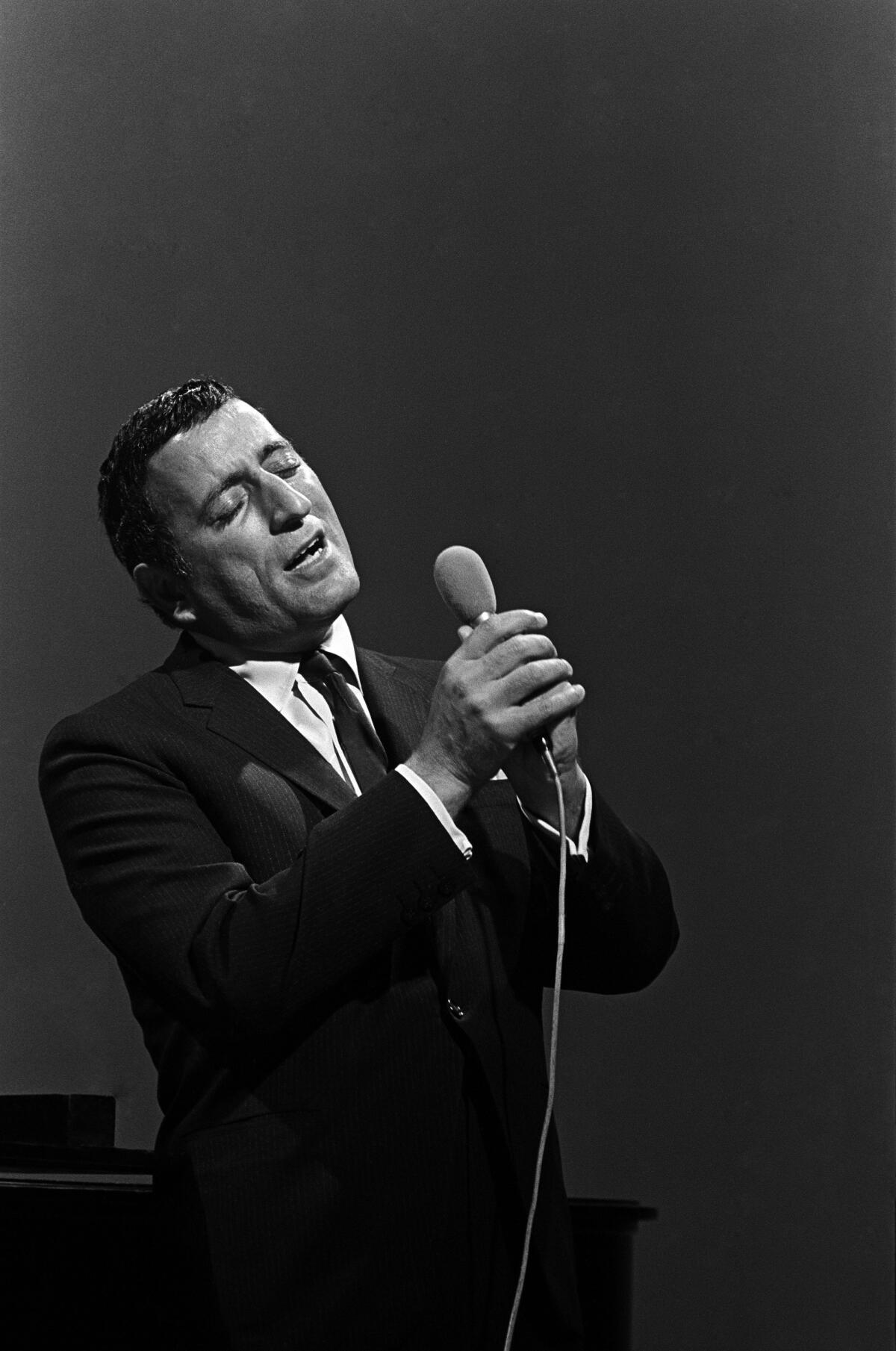
By the time rock began to dominate the airwaves in the 1960s, Bennett had secured his place in American music. Still, his career, like those of so many other artists who predated rock ’n’ roll, took a dip.
Unlike others who were forced off the scene, however, Bennett had an unexpected turn to his career in 1962 when a little song he thought would be a regional hit at best turned out to be not just hugely popular but his lasting legacy.
“I Left My Heart in San Francisco” was brought to him by his longtime pianist, Ralph Sharon, who had been given the song by two struggling songwriters, George C. Cory Jr. and Douglass Cross, hoping Sharon would pass it along to Bennett. Sharon stuck it in his shirt drawer and forgot about it.
When Sharon was packing to go on a tour with Bennett, he spotted it and gave it to the singer, thinking the fans in San Francisco might like it.
“We thought it was just like singing ‘New York, New York’ in New York,” Sharon told Billboard magazine in 1997.
San Francisco fans loved the song romanticizing their city, but Bennett still thought of it as only of regional interest.
But when he recorded it for the B side of “Once Upon a Time,” suddenly the foggy city “above the blue and windy sea” seemed to call out to everybody. Though the song never hit No.1, it was on the charts for two years and became an American standard.
Ten summers after Tony Bennett made his Hollywood Bowl debut in 1962, the Los Angeles Philharmonic advertised an evening featuring him at the Bowl with the orchestra and its music director, Zubin Mehta.
“I had had big hits before, but this song was off the map,” Bennett wrote in “The Good Life.”
In 2003, the Songwriters Hall of Fame established the “Towering Performance Award” to recognize “one-of-a-kind performances by one-of-a-kind singers.” The first recipient was Bennett singing “I Left My Heart in San Francisco,” which it called “one of the best examples of the true marriage of song and singer.”
San Franciscans forever afterward treated the singer as a native son. In a full embrace of the singer, civic leaders erected a statue of Bennett outside the Fairmont Hotel atop Nob Hill as a 90th birthday present. Bennett had made his San Francisco debut at the hotel in 1954.
“When people ask me if I ever get tired of singing ‘San Francisco,’ I answer, ‘Do you ever get tired of making love?’ That usually leaves them speechless.”
There was, however, a personal downside to the song. Its success and the increased touring that came with it took a toll on his marriage, and he and his wife, Patricia Beech, whom he married in 1952, separated shortly after the song was released.

Bennett went through tough times in the 1970s, when he fell behind on his taxes and had to deal with the IRS.
He also developed a serious cocaine habit and, as he recounted in his autobiography, one night he “overindulged and quickly realized I was in trouble.” As he was being rushed to the hospital, he said, he remembered something his manager had said about comedian Lenny Bruce, who died of a heroin overdose in 1966: “The man sinned against his talent.”
“That hit home,” Bennett said. “I realized I was throwing it all away, and I became determined to clean up my act.”
Besides his active performing and recording career, Bennett also continued his lifelong interest in painting. He took watercolors with him wherever he went and often turned these works into oil paintings. Some of his work, which he did under his given name of Anthony Benedetto, is included in a 1996 art book, “What My Heart Has Seen.”
And if he ever thought about stepping away from live performances, he said his audiences always managed to talk him out of it. Even after his family confided to AARP in 2021 that Bennett had been diagnosed with Alzheimer’s disease five years earlier, he continued to perform and recorded a new album, “Love for Sale,” with Gaga, who wept in the studio when Bennett delivered a flawless solo. Bennett said it would be his final album.
“There’s a lot about him that I miss,” his wife said. “Because he’s not the old Tony anymore. ... But when he sings, he’s the old Tony.”
Luther is a former Times staff writer.
Former staff writer Steve Marble contributed to this report.

More to Read
The biggest entertainment stories
Get our big stories about Hollywood, film, television, music, arts, culture and more right in your inbox as soon as they publish.
You may occasionally receive promotional content from the Los Angeles Times.
